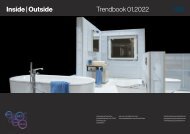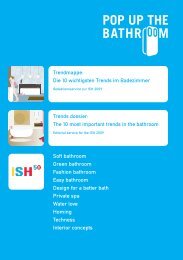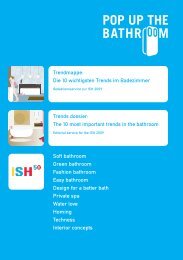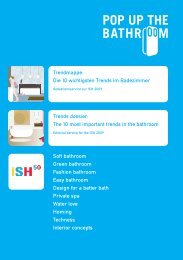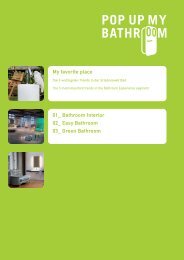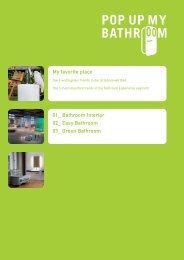My favorite place - Trendbook Pop up my Bathroom | Issue 01/2011 ISH 2011
Today’s bathrooms are no longer chilly, wipe-clean functional cells. Bathrooms are turning into living space. As simple as this meanwhile ubiquitously manifest megatrend might sound, its impact on the sanitary industry and the conceptual possibilities for bathroom design are nothing short of revolutionary. As a result, expectations of the aesthetics and functionality of contemporary bathroom design are growing. Accordingly, there will be more than “just” new products on show at the world’s leading fair for the sanitary industry, the ISH in Frankfurt. For it is not the bathtub that is being reinvented, but the entire bathroom.
Today’s bathrooms are no longer chilly, wipe-clean functional cells. Bathrooms are turning into living space. As simple as this meanwhile ubiquitously manifest megatrend might sound, its impact on the sanitary industry and the conceptual possibilities for bathroom design are nothing short of revolutionary. As a result, expectations of the aesthetics and functionality of contemporary bathroom design are growing. Accordingly, there will be more than “just” new products on show at the world’s leading fair for the sanitary industry, the ISH in Frankfurt. For it is not the bathtub that is being reinvented, but the entire bathroom.
Create successful ePaper yourself
Turn your PDF publications into a flip-book with our unique Google optimized e-Paper software.
Abgerundete Kanten und rutschhemmende<br />
Bodenbeläge und Fliesen schützen dabei nicht<br />
nur gebrechliche Menschen, sondern auch die<br />
Jüngsten vor Verletzungen. Und ein niedriger<br />
Waschtisch mit breiten Ablageflächen, die zum<br />
bequemen Schminken einladen und die tägliche<br />
Körperpflege wie auch die kleine Wäsche<br />
zappelnder Kleinkinder erleichtern, kommt<br />
allen zugute. Beispiele für die Variantenbreite,<br />
die ein Generationenbad erschließt, bieten etwa<br />
die Kollektionen Lifetime (Villeroy & Boch) oder<br />
Dejuna (Keramag). Sie demonstrieren eindrucksvoll<br />
die Gestaltungsfreiheit moderner Sanitärkollektionen<br />
für die universelle Nutzung.<br />
Wenn das Platzangebot stimmt, können solche<br />
„Universal Design“-Bäder auch im Nachhinein<br />
mit wenig Aufwand noch barrierefrei ausgebaut<br />
werden.<br />
Wer an später denkt, sollte beim Einbau von<br />
Unterschränken dennoch einen Raumsparoder<br />
Unterputz-Siphon wählen, um den Schrank<br />
bei Bedarf abnehmen oder seitlich verschieben<br />
zu können, damit Platz für genügend Beinfreiheit<br />
und Sitzgelegenheiten geschaffen wird.<br />
Hinzu kommen Details, die von der Industrie<br />
bei den entsprechenden Produkten schon vorgesehen<br />
sind: So erleichtern Griffmulden oder<br />
Griffe das Heranziehen, wenn ein Hocker oder<br />
ein Rollstuhl benutzt wird. Und wenn der Spiegel<br />
tief genug ansetzt, braucht er auch nicht<br />
mehr gekippt zu werden, damit sich auch<br />
Rollstuhlfahrer und Kinder darin sehen können.<br />
Der zum Teil ausgeprägten Sicherheits- und<br />
Komfortsensibilität älterer Konsumenten trägt<br />
die Industrie mit hygienischen Oberflächen<br />
und Produktfeatures wie WC-Duschen, beheizbaren<br />
oder mit Sicherheitsleuchten ausgestatteten<br />
Sanitärobjekten Rechnung.<br />
Vor allem aber ist ein „einfaches“ Badezimmer<br />
menschlich. Es ist darauf ausgelegt, Fehler zu<br />
tolerieren, mitzudenken, Normalität zu vermitteln.<br />
Deshalb steht auch die Technik im Dienste<br />
des Menschen. Sie hilft nur so weit, wie sie<br />
gebraucht wird; danach verschwindet sie wieder<br />
aus dem Gesichtsfeld. Einmal eingestellt, reicht<br />
ein Knopfdruck, um individuelle Programme<br />
mit komplexen Abläufen abzurufen. Nur groß<br />
genug sollten die Tasten sein, und niedrig<br />
installiert. Damit nicht nur Papa, sondern auch<br />
Oma und Enkel in den Genuss eines genau<br />
dosierten Wohlfühlprogramms kommen.<br />
Text: Claudia Wanninger<br />
30<br />
a riser rail and the horizontal handle doubles<br />
as a mounting element for a removable seat.<br />
Rounded edges and slip-resistant flooring or<br />
tiles don’t just protect frail people from injury,<br />
they’re safer for children too. And everybody<br />
benefits from a low wash basin with plenty of<br />
storage surfaces: it’s perfect for applying make<strong>up</strong><br />
and makes it easier to perform daily hygiene<br />
routines or wash squirming toddlers. Examples<br />
of the broad spectrum of variants available for<br />
a multigenerational bathroom include collections<br />
like Lifetime by Villeroy & Boch or Dejuna<br />
by Karamag. They are an impressive demonstration<br />
of the unfettered creativity that characterises<br />
modern bathroom collections for universal<br />
usage. If sufficient space is available, a bathroom<br />
with this kind of “Universal Design” can easily<br />
be adapted and made barrier-free should the<br />
need arise later on.<br />
Even so, anybody planning their bathroom with<br />
an eye to the future should opt for a spacesaving<br />
or concealed sink trap when fitting<br />
washbasin cabinets so that, if the need arises,<br />
they can be removed or repositioned in order<br />
to create space for the necessary leg room and<br />
seating. There are other useful details that the<br />
industry is already equipping the corresponding<br />
products with: grips or handles make it<br />
easier to pull things within easy reach when<br />
using a stool or wheelchair. And if the mirror<br />
is positioned sufficiently low, it doesn’t need<br />
to be tilted in order for wheelchair users or<br />
children to see themselves in it. The industry<br />
is responding to older consumers’ sometimes<br />
pronounced safety and convenience concerns<br />
with hygienic surfaces and product features<br />
such as shower toilets, heated fixtures or<br />
fittings equipped with safety lights.<br />
More than anything else, however, an “easy”<br />
bathroom is human. It is geared towards tolerating<br />
mistakes, doing some of the thinking for<br />
its users and conveying a sense of normality.<br />
That is why even the technology is at the<br />
service of its human users. It only helps as<br />
much as it is needed before disappearing<br />
from view again. Once the settings have been<br />
made, all that’s needed is a push of a button<br />
to activate individual programmes with<br />
complex sequences. But the buttons have to<br />
be big enough and installed low down. That<br />
way, dad isn’t the only one who can enjoy<br />
a customised wellness routine: granny and<br />
the kids can pamper themselves as well.<br />
Text: Claudia Wanninger



